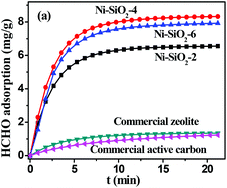Microemulsion-assisted synthesis of hierarchical porous Ni(OH)2/SiO2 composites toward efficient removal of formaldehyde in air
Abstract
Ni(OH)2/SiO2 composites with hierarchical flake-like nanostructures were synthesized using water-in-oil microemulsion and characterized by X-ray diffraction, thermogravimetry, Fourier transform infrared spectroscopy, scanning electron microscopy, transmission electron microscopy, nitrogen adsorption, and X-ray photoelectron spectroscopy. The as-prepared hierarchical porous Ni(OH)2/SiO2 composites show an excellent performance for formaldehyde (HCHO) removal in air at an ambient temperature. It was found that the aging time had a significant impact on the pore structure, surface area and HCHO adsorption. The Ni(OH)2/SiO2 composite aged for 4 h in the presence of tetraethyl orthosilicate (TEOS) exhibited a relatively high HCHO adsorption capacity as well as good recyclability compared with Ni(OH)2, attributed to a relatively large BET surface area, an optimal pore size, a suitable proportion between Ni(OH)2 and SiO2, and a synergistic effect between Ni(OH)2 and SiO2. The results from this work not only demonstrate that hierarchical porous Ni(OH)2/SiO2 composites can act as an efficient adsorbent toward HCHO in air, but suggest a new route for the rational design of cost-effective, high-performance and environmentally benign adsorbents for indoor air cleanup.


 Please wait while we load your content...
Please wait while we load your content...